Have you ever struggled to pull current daily sales reports from Salesforce, only to find that their numbers don’t match the business intelligence dashboards that finance is tracking? Another pain is when Marketing is using spreadsheets of campaign data that never get reconciled with pipeline forecasts. These are the typical examples of data silos.
Salesforce is very good at managing customer relationships, but wasn’t designed for big-data analytics or analysis of historical trends. Running complex queries in Salesforce directly can slow down the system. Combining them with external datasets, such as marketing spend or service tickets, is typically not feasible without further measures.
That’s where integrating Salesforce with a cloud data warehouse comes in. Loading data into platforms like Snowflake, BigQuery, or Redshift can open a 360° customer view, improve reporting performance, and unlock advanced analytics.
In this guide, we’ll cover:
Table of Contents
- Why Integrate Salesforce with a Data Warehouse?
- Core Methods: How to Get Data From Salesforce to Your Warehouse
- Method 1: Manual Extraction (Native Salesforce Tools)
- Method 2: Custom API Integration
- Method 3: No-Code/Low-Code Data Integration Platforms (The Modern Approach)
- Choosing the Right Data Warehouse for Your Salesforce Data
- Step-by-Step: Your Salesforce Integration Project Plan
- Conclusion
Why Integrate Salesforce with a Data Warehouse?
According to Salesforce, a data warehouse acts as a single source of truth. It supports better business decisions and business-intelligence activities by consolidating structured data from sources like CRM, POS systems, and marketing platforms.
That’s why organizations across industries are considering connecting Salesforce to a data warehouse. Let’s break down the core reasons.
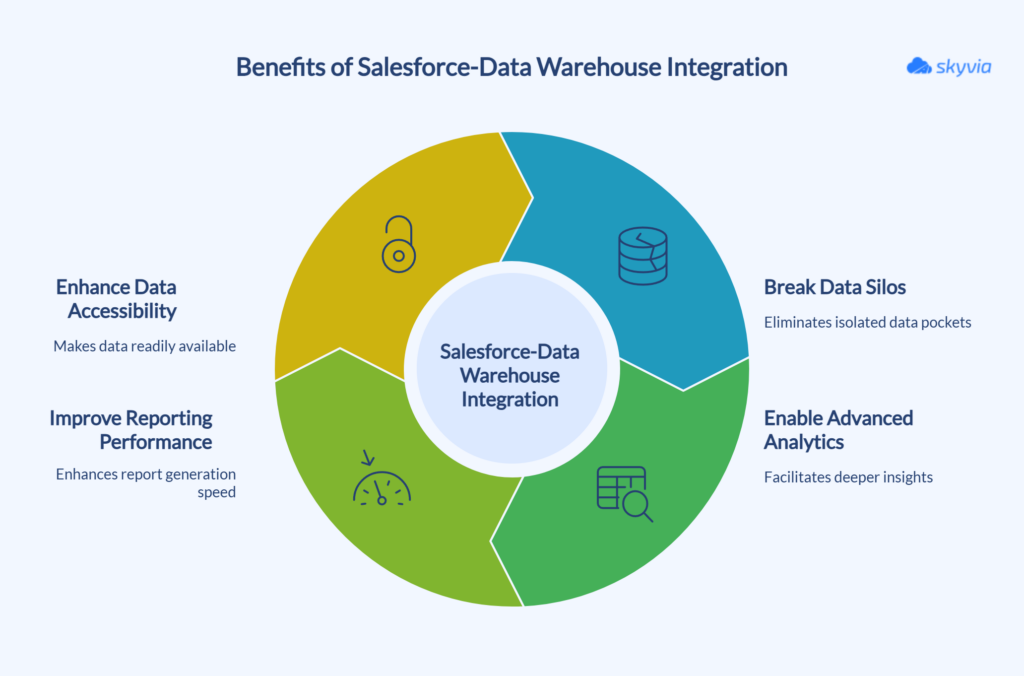
Break Down Data Silos
Not many companies run entirely on Salesforce. Marketing works in HubSpot or Google Ads, finance operates in ERP software, and support functions use Zendesk or Jira.
Without integration, every team works in a silo by itself. A data warehouse consolidates it all into one place of truth. Instead of reconciling multiple tools’ numbers, leaders can make decisions based on one reliable dataset.
Enable Advanced & Historical Analytics
Salesforce reporting is ideal for operational questions like “What’s closing this quarter?” Data warehouse opens more opportunities for comprehensive analysis:
- Running complex queries against years’ worth of records
- Tracking long-term trends
- Combining Salesforce data with external data
For example, determining how ad spend will drive lifetime customer value is a matter of joining opportunities with marketing and finance data sets. This may happen only after the data coexist in a warehouse.
Improve Reporting Performance
The more sophisticated your reports are, the longer they will take to execute. Streaming analytics to a warehouse prevents performance bottlenecks in Salesforce itself. Its minutes-long queries can run in seconds within an analytics-driven warehouse.
By doing this, sales reps won’t need to sit around waiting for dashboards to render, and business intelligence teams won’t have to do the math at the expense of the CRM.
Enhance Data Accessibility
A final advantage of Salesforce data warehouse integration is the simplicity of access. Because data is stored in Snowflake, BigQuery, or Redshift, BI tools like Tableau, Power BI, or Looker, can query data from data warehouses directly.
Analytics is no longer exclusive to Salesforce users. Operations, finance, and even product departments can all access customer insights. Cross-functional collaboration through shared data is the result.
Core Methods: How to Get Data From Salesforce to Your Warehouse
There are several ways to load records into a warehouse. Each method has its strengths and weaknesses, and the best choice depends on your business size, technical capacity, and data needs.
| Method | Cost | Complexity | Best For |
|---|---|---|---|
| Manual Extraction (Reports, Data Loader) | Free (built-in) | Low | Small businesses, one-off exports |
| Custom API Integration | High (dev hours) | High (API management, error handling) | Enterprises with IT teams & strict compliance |
| No-Code/Low-Code Platforms (e.g., Skyvia) | Subscription-based (varies) | Low (drag-and-drop UI) | SMBs to large enterprises seeking automation |
Method 1: Manual Extraction (Native Salesforce Tools)
What it is: Pulling the records using Salesforce’s built-in reports, scheduled data exports, or Data Loader, and then manually uploading them into your data warehouse.
Pros
- Free and included in Salesforce.
- No need for extra tools or subscriptions.
- Fine for occasional, one-off exports.
Cons
- All manual and time-consuming.
- Not good for frequent updates.
- High risk of errors, especially for large datasets.
- Needs someone to monitor and rerun the process.
Best for:
Small businesses or teams for one-off snapshots of Salesforce data for analysis.
Method 2: Custom API Integration
What it is: Writing custom code or creating a custom app against Salesforce APIs (REST, SOAP, or Bulk API) to extract data and load it into the warehouse.
Pros
- Full control over what data is moved and how.
- Can handle custom objects and fields.
- Can be tuned for near real-time updates.
Cons
- Requires experienced developers.
- Long development cycles and ongoing maintenance.
- High initial cost compared to other approaches.
Best for:
Large enterprises with dedicated IT teams and strict needs for customization or compliance.
Method 3: No-Code/Low-Code Data Integration Platforms (The Modern Approach)
What it is: Using cloud-based ETL/ELT tools such as Skyvia, which provide pre-built Salesforce connectors and automate the entire pipeline without coding.
Pros
- Fast setup, no coding required.
- Works for small and enterprise-scale volumes.
- Supports scheduled and incremental loads.
- Usually offers monitoring and logging features.
Cons
- Advanced features are available for paid subscriptions.
Best for:
Growing businesses that need reliable, automated pipelines without dedicating additional developer resources.
Choosing the Right Data Warehouse for Your Salesforce Data
Choosing the right destination for your Salesforce data is as important as choosing the integration method.
While all cloud data warehouses enable features like scalability, high-level query performance, and BI tool support, each excels at something. Let’s look at the top three the most popular ones.
Salesforce to Snowflake
Snowflake is perhaps the most widely employed cloud warehouse because it is highly versatile and has a unique architecture. It separates storage from the compute, so you can just store lots of data without additional processing cost unless you need it.
This is an excellent advantage for Salesforce users: you can have a history going back years without the processing cost.
Why it works well for Salesforce:
- Stores unlimited amounts of data at low cost.
- Scalable depending on workload.
- Works across multiple cloud providers (AWS, Azure, Google Cloud).
- Handles both regular Salesforce records (structured data) and more complex formats (semi-structured data like JSON).
Best fit: Companies that want flexibility, predictable costs, and the option to work across different cloud providers.
Learn how to replicate Salesforce data to Snowflake in just a few clicks, and then sync (Reverse ETL) Snowflake data back to Salesforce with no coding required.
Salesforce to Google BigQuery
BigQuery is Google Cloud’s fully managed, serverless warehouse. You don’t need to worry about managing servers or infrastructure.
It automatically scales to handle your data as it grows, making it a stress-free option for many businesses.
Why it works well for Salesforce:
- It is serverless, so no technical setup is required.
- Native integration with Google products like Analytics, Ads, and Looker.
- Pay-per-query model.
- Extremely fast for running large queries across Salesforce history.
Best fit: Businesses already using Google Workspace or Google Cloud, or those that need ad-hoc Salesforce analytics and flexible reporting without managing infrastructure.
See how to integrate Salesforce and Google BigQuery in any direction with no coding.
Salesforce to Amazon Redshift
Redshift is Amazon’s data warehouse solution and a core part of the AWS ecosystem. It is known for speed at scale, especially when dealing with massive datasets.
Why it works well for Salesforce:
- Deep integration with AWS tools like S3 (storage) and Glue (data preparation).
- Strong performance with large datasets.
- Long track record in enterprise environments.
- Offers advanced security and compliance features for regulated industries.
Best fit: Large organizations already running their systems on AWS who need to fold Salesforce into existing pipelines.
Note: The warehouse you choose should align with your broader cloud strategy. If your company is already running workloads in Google Cloud, BigQuery might be the natural choice. If you’re AWS-heavy, Redshift may fit better. Companies often choose Snowflake for its cross-cloud flexibility.
Check how to connect Salesforce and Redshift in the complete integration guide.
Step-by-Step: Your Salesforce Integration Project Plan
The integration of Salesforce with a data warehouse is not just a matter of transferring records from one application to another.
You need to handle it as a formal procedure to ensure the project’s success. Here’s a high-level roadmap that helps avoid common pitfalls and ensures a smooth rollout.
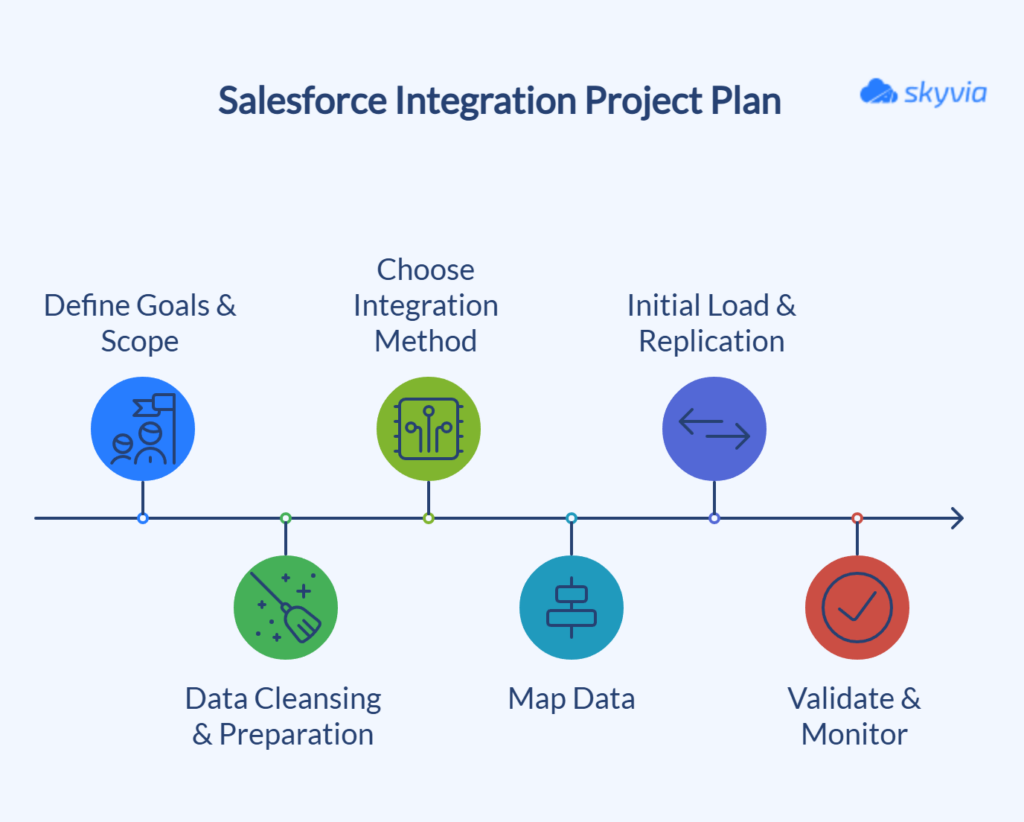
Step 1: Define Your Goals and Scope
Start by asking why you are connecting Salesforce to a data warehouse. Are you looking for better sales forecasts?
Do you need to combine marketing and sales data? Or are you aiming for long-term customer trend analysis?
Clearly define:
- The business questions you want to answer.
- Which Salesforce objects matter most (e.g., Accounts, Opportunities, Contacts).
- Which teams will use the data (sales, finance, operations, marketing).
This step prevents you from moving unnecessary data and keeps costs manageable.
Step 2: Clean and Prepare Your Data
The source often contains duplicates, outdated records, or missing fields. Cleaning it up before loading it into the warehouse ensures reliable analytics. Think of it as if it were moving into a new house. You wouldn’t pack clutter you no longer need.
Note: Run a quick Salesforce audit. Remove duplicates, standardize formats (like country names), and validate necessary fields before integration.
Step 3: Choose Your Integration Method
Refer back to the three mentioned approaches (manual, custom API, or no-code platform). For most growing businesses, a no-code tool like Skyvia is the fastest and most cost-effective way forward, while enterprises with strict rules may prefer API-driven methods.
Step 4: Map Your Data
When moving Salesforce data into a warehouse, one crucial step is making sure the fields match correctly between systems. This process is called data mapping.
Column names and data types may be different in the source and target.
Without mapping, the warehouse wouldn’t know how to process it. Mapping ensures consistency, avoids errors, and enables the execution of accurate queries later on.
However, not every integration requires manual mapping. Another approach is to copy your whole Salesforce schema directly into the warehouse. Tools like Skyvia Replication can automatically duplicate source objects and fields in the target warehouse and track changes. In this case, you don’t have to worry about mapping at all, since the schema in the warehouse mirrors Salesforce itself.
Step 5: Perform the Initial Load and Plan Ongoing Syncs
Your first load will typically involve moving all historical records into the warehouse. This may take time, especially if you have years of data.
Once that’s done, set up scheduled incremental updates to catch new or changed records (via Change Data Capture (CDC) or API-based syncs). This keeps the warehouse current without overloading Salesforce.
Step 6: Validate and Monitor
Finally, always make sure the warehouse is in sync with Salesforce data. Conduct spot checks on field values and record quantities. Once verified, set up monitoring and alerts so you are notified if a pipeline fails or data no longer flows.
Integration Best Practices for Reliable, Performant Pipelines
Having your first Salesforce-to-data warehouse connection up and running is a victory, but reliability over the long term depends on sticking with well-established best practices.
Collectively, these best practices allow you to break through an ad-hoc project and build a scalable integration framework that matures alongside your company.
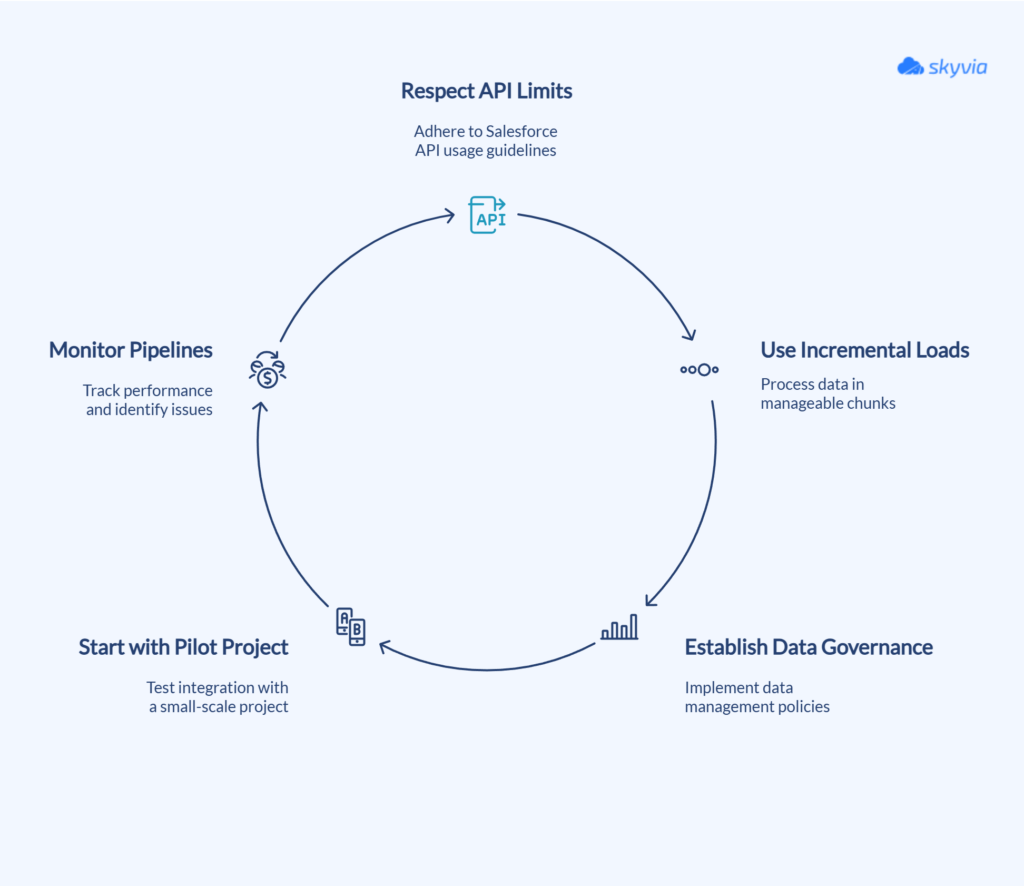
Respect Salesforce API Limits
Salesforce imposes daily API request limits. If your integration exceeds them, pipelines can fail and impact other processes.
Modern ETL/ELT platforms automatically throttle requests and retry as needed. If you’re managing APIs yourself, you’ll need to design around these limits carefully.
Use Incremental Loads
If your scenario involves frequent data loads, then reloading all of your Salesforce data each time is inefficient and often unnecessary.
Instead, enable Change Data Capture (CDC) or incremental syncs to track only the latest updates. This reduces load times, lowers API consumption, and keeps warehouses consistently updated.
Establish a Data Governance Plan
When you move Salesforce data to a warehouse, don’t forget about compliance, security, and quality. Define clear rules around who owns the data, who can access it, and how it should be validated. This prevents reporting discrepancies and keeps your business audit-ready.
Start with a Pilot Project
Instead of deploying all the Salesforce objects at once, start with the key ones, such as Accounts and Opportunities.
Pilot project enables you to test the pipeline, validate the data, and tune the performance before deployment to the whole Salesforce org.
Monitor Your Pipelines
Even the best integration setup can run into occasional issues like schema changes, expired credentials, or API outages. Monitoring and alerts keep you aware of problems before they affect decision-making.
The Skyvia Advantage: Salesforce Integration Without the Complexity
Many businesses start their Salesforce data warehouse integration journey with manual exports or custom APIs, only to realize that both paths are difficult to sustain. What about a no-code solution?
Skyvia is a versatile no-code integration platform that offers a dedicated Salesforce connector and enables integration with over 200 other applications, including leading data warehouses.
Built for Salesforce
Salesforce has a unique architecture, strict API limits, and often involves custom objects. Skyvia Salesforce connector can help you perform ETL/ELT and Reverse ETL, build pipelines, share data via REST API, and more. It supports standard Salesforce objects as well as custom objects.
Truly No-Code
Not every team has a developer on standby. With Skyvia, data pipelines are built through a visual interface.
Drag, drop, schedule, and you’re done. No scripts, no maintenance of custom code, no firefighting when APIs change.
Automated and Reliable
Skyvia automatically manages scheduling and monitoring. Its tools can even handle errors. That means your pipelines run in the background.
You don’t need to control all your integrations constantly. Skyvia will write down the integration logs and notify you about errors, if needed.
More Than Salesforce
While Salesforce might be your immediate concern, Skyvia supports over 200 applications, including marketing platforms, accounting software, cloud storage services, and databases.
This makes it easy to implement complex multi-function scenarios involving various apps, with Salesforce as just one part of the bigger picture.
Skyvia Solutions
It takes several clicks to set up Salesforce data warehouse integration. In a nutshell, you specify the source, target, and select the objects to replicate.
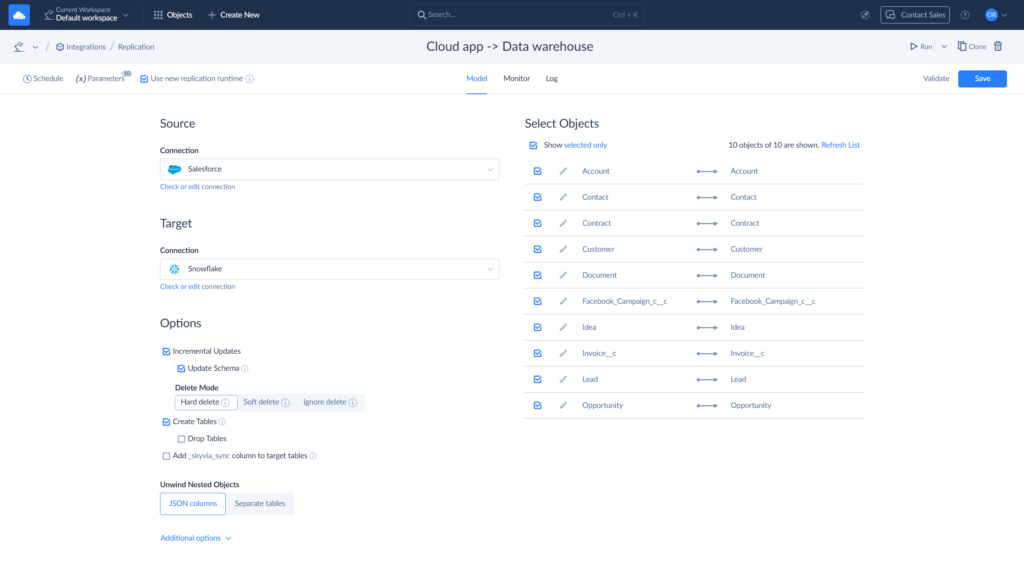
With Skyvia, you can implement advanced integration scenarios by building your custom data flows involving multiple targets and complex integration logic.
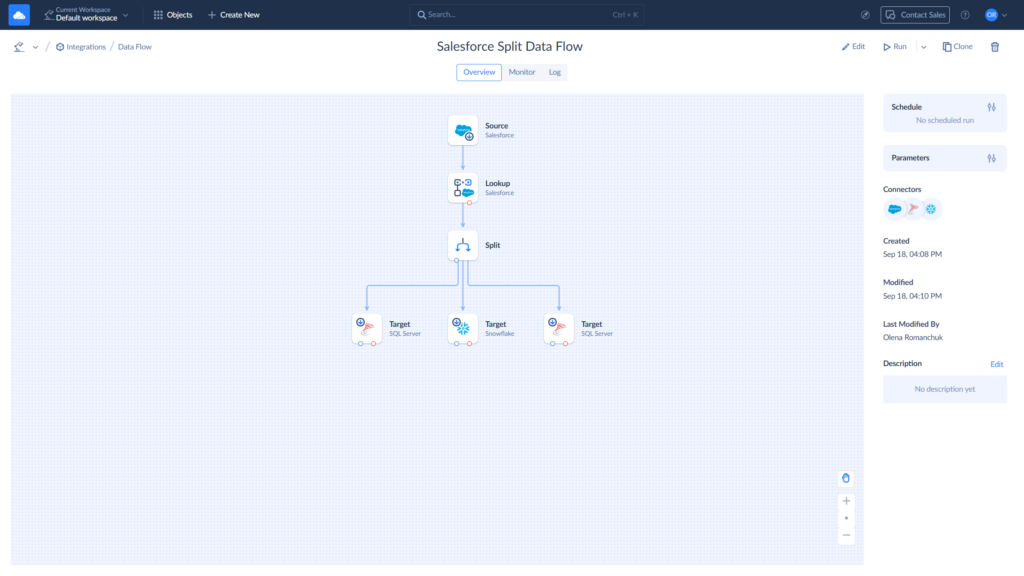
Conclusion
Integrating Salesforce with a data warehouse delivers clear business value: it breaks down silos, improves reporting performance, and enables advanced analytics that Salesforce alone cannot provide. By merging data in platforms like Snowflake, BigQuery, or Redshift, companies unlock advanced reporting, long-term trend analysis, and a single source of truth for decision-making.
Among the available approaches, manual exports are too limited, and custom APIs can be costly to maintain. Automated no-code platforms offer the most sustainable path, especially when paired with integration best practices like incremental loads, governance, and monitoring.
Modern no-code platforms like Skyvia offer a faster, more reliable way to connect Salesforce with warehouses and beyond. With automated updates, support for native and custom objects, and over 200 additional connectors, Skyvia helps organizations build pipelines that are both resilient and future-ready.
In a world where decisions increasingly depend on real-time insights, having Salesforce integrated into your broader ecosystem is a competitive advantage.
F.A.Q. for Salesforce Data Warehouse
What is the difference between ETL and ELT for Salesforce?
ETL extracts Salesforce data, transforms it before loading, while ELT loads data first into the warehouse and applies transformations there, offering more flexibility and scalability.
Can I load Salesforce custom objects into a data warehouse?
Yes. Modern integration platforms like Skyvia support both standard and custom Salesforce objects, ensuring that even non-standard structures are replicated.
How do I handle formula fields when integrating Salesforce?
Formula fields are recalculated in Salesforce, not stored. They can be re-computed in the warehouse or exported as static values, depending on your integration method.



